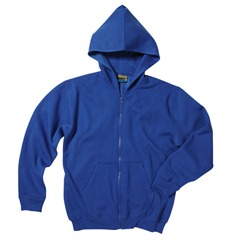A fleece jacket or fleece is a lightweight casual jacket  made of polyester synthetic wool such as Polar Fleece. A fleece jacket will typically have a zipper up the middle, rather than buttons or other fasteners. A fleece will provide thermal insulation but is not normally weatherproof and so won't keep out wind and rain.
made of polyester synthetic wool such as Polar Fleece. A fleece jacket will typically have a zipper up the middle, rather than buttons or other fasteners. A fleece will provide thermal insulation but is not normally weatherproof and so won't keep out wind and rain.
Fleece jackets entered the outerwear market in 1979 after the key component, polar fleece, was created by a company called Malden Mills. Polar fleece was developed from a combination of synthetic fibers and sheep wool and is simply called "fleece" in today's market. The wool component makes fleece jackets especially warm and provides insulation for the wearer's body heat, while the synthetic fibers assist with heat retention. Because of its unique combination of materials, fleece jackets are usually lighter than a heavy wool jacket would be.
Types are, Women, Uniqlo, Men, with or without Hood, with or without sleeves are produced as different styles.
Material | Benefits | Drawbacks |
| Synthetic Fiber | Usually water-resistant Inexpensive Flexible | Not very durable Heavier than down |
| Down | Lightweight Warm Durable | Not always water resistant Loses heat retaining capacity when wet Dries slowly High price tag |
| Fleece | Comfortable Fairly lightweight Warm Inexpensive | Not usually water resistant May be bulky or inflexible due to waterproof or windproof layer |
Features to Look For in a Fleece Jacket
While buyers will need to tailor their search to their specific needs, there are seven features that most women will want to look for in a fleece jacket. These seven key features are material and weight, breathability, water resistance, windproof layers, a snug collar and wristbands, zippers with wind flaps, and a sufficient number of pockets.
a sufficient number of pockets.
Material and Weight.
- Breathability.
- Water Resistance.
- Windproof Layers.
- Collars and Wrists.
- Zippers and Wind Flaps.
- Pockets.
1. Material and Weight
Many fleece jackets are made of wool and polyester. While early fleeces were fairly flammable, modern fleece jackets typically incorporate fire retardant or flame resistant technology. The primary purpose of a fleece jacket is warmth for the wearer. However, the situations in which the jacket will be used may vary widely among buyers and can affect the style of fleece that is ultimately c hosen.
hosen.
Fleece jackets are generally lighter than wool coats. Within their own category, they range from lightweight to mid-weight to heavy. On the label, the jacket's weight range is indicated by either a 100, 200, or 300 designation, with 300 being the heaviest material. To determine how heavy their fleece jacket should be, buyers will need to consider the amount of flexibility they will need while wearing the jacket.
For mild to medium levels of activity or for cool times of the year such as spring or fall, a mid-weight fleece jacket will likely suffice. A lighter one will probably provide better flexibility for very active sports, while the heaviest types of fleece jackets should be reserved for winter work or for pastimes that are slow moving or stationary and will not offer much opportunity for aerobic activity. In these situations, wearers' hearts are not pumping as fast and their extremities and limbs can become chilled more quickly. The heavier the fleece jacket, the more body heat that will be trapped close to the wearer's skin.
Some buyers may purchase a lightweight fleece jacket or vest as one of several layers, which they can add or remove depending on their needs during a particular activity. The fleece jacket may be worn over a short - sleeved T - shirt or a flannel shirt and under a windbreaker, for instance. The fleece provides a snug layer of warmth that can be discarded if wearers become too hot or added if the activity level drops and they become cold.
2. Breathability
Airflow and breathability is also important. Trapping all of the heat inside will cause wearers discomfort, particularly if they are involved in an activity that requires significant exertion. Buyers who plan to wear the jacket for high-energy activities will need to ensure that it adequately blocks the cold while still allowing enough ventilation to alleviate sweating or overheating.
3. Water Resistance
Fleece jackets are generally not waterproof. Not all are water resistant, either, since water resistance typically hinders breathability. Those fleeces that have limited water resistance incorporate an impermeable layer within the material. While they will likely provide some protection against snowfall or light drizzle, they may not suffice in a freezing winter rain.
4. Windproof Layers
Windproofing is also a valuable feature in a fleece jacket, since the snow and rain of winter typically comes paired with biting winds. Unfortunately, windproof layers may cause the jacket to lose some of its suppleness and flexibility. Windproofing also cuts down on breathability in the same way that water resistant layers do. For walking or mild outdoor activities, a windproof fleece jacket is an excellent choice. For activities requiring strenuous physical effort, buyers may want to skip the windproof layer in favor of better airflow.
5. Collars and Wrists
Cold air can seep in at the collar and at the wrists of a fleece jacket. A collar or additional lining at the neck of the jacket warms the wearer's neck. Buyers should consider a jacket with elastic bands at the wrists and possibly at the bottom of the jacket. Though this may detract a little from the style of the jacket, it will preserve body heat while keeping out the icy winter air.
Another option for wrist closures is Velcro. Velcro strips allow users to tighten the cuffs of the jacket without having to deal with the cinched look of elastic. In warmer weather, sleeves with Velcro at the wrists can be rolled up with no damage, whereas rolling up elastic cuffs will stretch out and possibly snap the elastic bands.
Buyers may also be interested in a fleece jacket with a hood. Although these are rare for the style, they offer additional protection for the wearer's neck and head.
6. Zippers and Wind Flaps
Aside from serving as a convenient closure, a zipper provides a way to vent a fleece jacket if the wearer is becoming overheated. The zippers in fleece jackets should have wind flaps to further reduce the potential influx of cold air. A wind flap is a long, narrow piece of fabric sewn in just beneath the zipper, providing an extra layer of protection so that the wearer's body heat does not escape and icy air does not get in.
7. Pockets
Many stylish fleece jackets either have no pockets or have very shallow ones. However, if the jacket is being used for a camping trip or for a hike, some additional pockets would likely be useful. Buyers should look for pockets that are situated at the waistline and have enough depth to hold keys, a cell phone, snacks, chewing gum, and other small items. Zippers or flaps with buttons hold pockets closed to prevent their contents from slipping out. Some fleece jackets designed for hiking and winter sports have pockets on the chest and the arms. Buyers who plan to wear their fleece jackets for sports or for similarly vigorous activity may want to consider a fleece jacket with mesh pockets for additional ventilation options.


EmoticonEmoticon